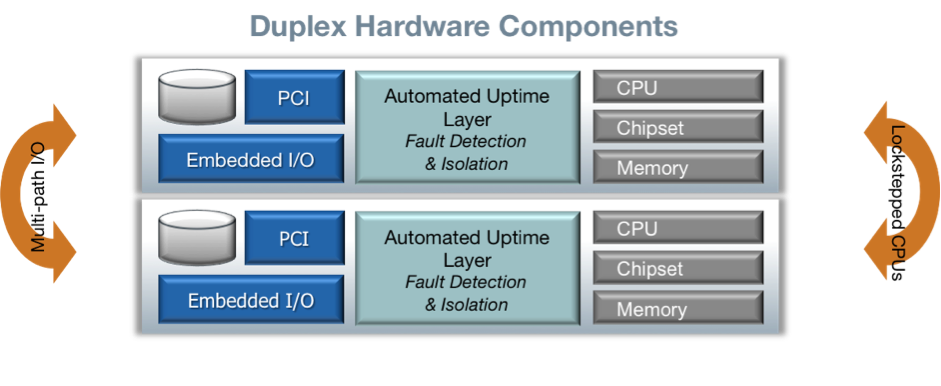Stratus

ftServer®
Each ftServer® platform integrates fully replicated hardware components that eliminate virtually any single point of failure and safeguard data integrity. The system automatically manages its replicated components, executing all processing in lockstep.
Because replicated components perform the same instructions at the same time, there is zero interruption in processing, zero loss of performance, and zero loss of data integrity even if a component fails. This means that, unlike a high-availability cluster, the Stratus ftServer continues to function while any issue is being resolved.
The architecture uses industry-standard technology and commodity components, making the platform cost-effective to manufacture and easy to upgrade as enhanced and improved components are brought to market.
How Lockstepping Works
Stratus® ftServer® platforms use a standard dual-modular-redundancy (DMR) configuration that includes two CPU/memory units. If a CPU / memory unit fails or is offline for maintenance or diagnostic purposes, the system continues to operate normally with the remaining components, providing 99.999% uptime or better – on average less than five minutes of downtime annually.

EverRun Enterprise
Continuous availability – now a global requirement – touches every part of our lives. And the need for continuously available applications has become more pervasive across all market sectors – from building automation, to industrial automation and public safety across communities worldwide.
Two servers are linked via a virtualization platform that pairs protected virtual machines together to create a single operating environment. We call this technology everRun Availability Services. In fault-tolerant mode, if one physical machine should fail, the application will continue to run on the other physical machine without any interruptions or data loss. In high availability mode, one machine is active, the other is on standby. If one machine fails, the application restarts on the standby machine with minimal interruptions or data loss. In both fault-tolerant and high availability mode, if a hardware component fails, everRun substitutes the healthy component from the second system until the failed component is repaired or replaced.
The I/O is automatically mirrored to the redundant server. This “statepointing” ensures all in-flight transactions as well as data in memory and cache is preserved — without machine restarts or data loss when run in fault-tolerant mode.
We build an operating environment utilizing KVM on one server. Then, we add our Stratus Availability Extensions to create the fault-tolerant environment. Once built, an availability link is used to duplicate and continuously communicate with the 2nd server.



